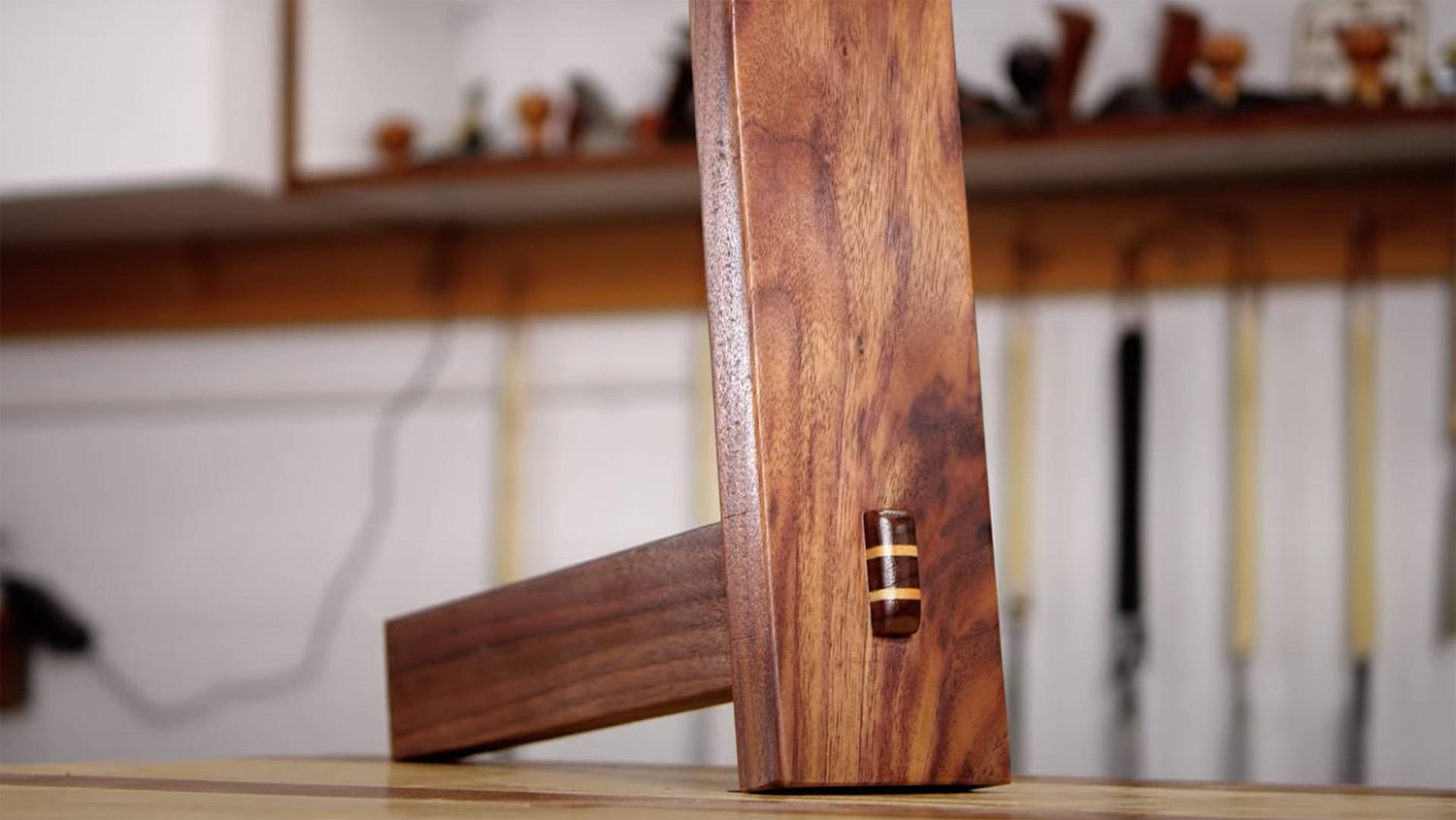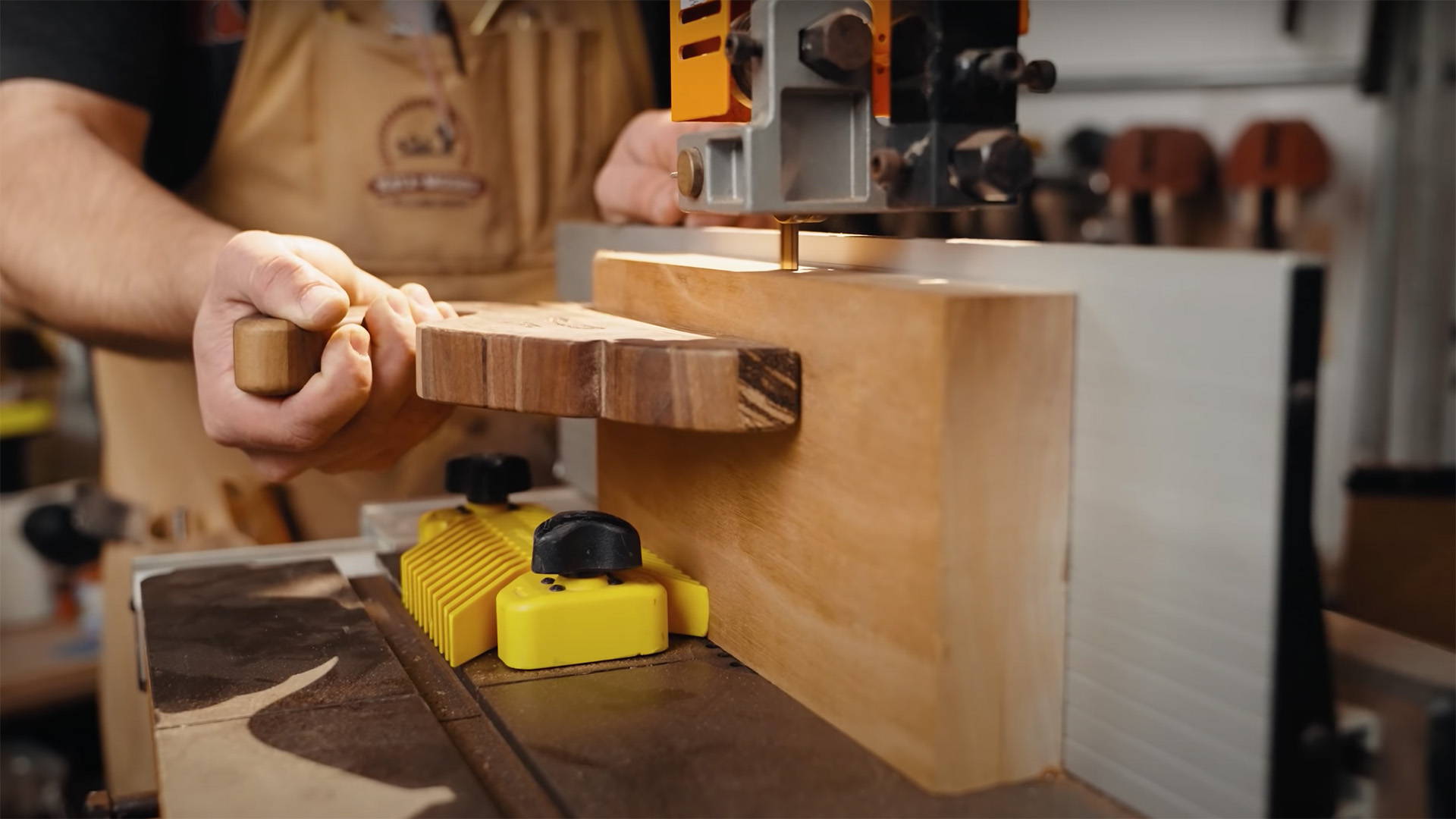There’s probably no joinery style as fundamental as the mortise and tenon.
It’s a simple joint. But getting it right is trickier (and more time consuming) than you might think.
That said, it’s absolutely worth the effort to learn.
If you can master mortise and tenon joints, you’ll have the skills to cut almost any other style of joinery.
So to help out, I’m giving you a few different ways to cut this essential joint — plus some tips to get better results right away.
HOW A MORTISE AND TENON JOINT WORKS
Mortise and tenon joints are used to connect two boards together at (typically) 90°.
The mortise is a rectangular hole which the tenon fits into. It’s pretty biological, if you think about it (don’t).
You’ll most often see mortises used in the legs of furniture, with the tenons cut on the stretchers, aprons, or panel sides.
The two most common types are:
- Stopped Mortise: The mortise doesn’t go all the way through the board, and the tenon is completely hidden
- Through Mortise: The mortise goes all the way through the board, and the end of the tenon is exposed
It’s a super strong joint because the tenon is supported on all four sides — and when laid out correctly, there’s plenty of long grain to long grain glue contact.
DIFFERENT WAYS TO CUT A MORTISE
Mortises are the most time consuming part of this joint.
Pretty much any way you do it, you’ll have to use a chisel at some point. So be sure to brush up on good chisel technique.
CUT A MORTISE WITH ONLY CHISELS
A mortising chisel is the go-to tool for hand cut mortises — and their width often determines the width of the mortise.
Honestly though, you don’t need one. They’re great, but I personally just use my bench chisels.
The most important thing is to use a marking knife or marking gauge for your layout lines.
It gives you a physical reference for your chisels — and improves your accuracy a ton.
But don’t start in your marking knife lines. First, clear out all the waste you can, staying away from your lines.
Cut the remaining waste in half until there’s no other option than to set your chisel in the knife lines and finish the edges — but avoid the corners.
When the sides are mostly done, use them as a reference to swivel your chisel down into the corners for a perfectly clean cut.
For through mortises, don’t chisel all the way through. Cut halfway through, then flip the board and work from the other side.
This will keep you from blowing out your lines on the opposite face.
Of course, the real key to success is lots and lots (and lots) of practice. No one’s ever hand-cut a perfect mortise on their first try.
Keep at it, and read this for more tips on chisel technique.
CUT A MORTISE WITH A DRILL PRESS AND CHISELS
To clear most of the waste in one fell swoop, I first take my mortises to the drill press.
Use a forstner bit that’s slightly smaller than your mortise, and drill down to the appropriate depth. You might have to drill multiple holes for longer mortises.
If it’s a through mortise, use a backer board to avoid tearout.
Once that’s done, use a chisel to clean up the edges as described above.
This is my most used mortise strategy, and it saves a ton of time.
You can also use a plunge base router in place of a drill press. Just make sure it’s steady and use an up-cut spiral bit to clear sawdust efficiently.
CUT A MORTISE WITH A ROUTER
Cutting mortises with a router is quick and accurate — but takes some careful set up.
Where possible, I like to use a router bit that’s the full width of my mortise. That way, I get perfect edges in a single pass.
You’ll need a good edge guide or jig to keep your cut lined up, and consider clamping down some boards as temporary stop blocks for your top and bottom edges.
Then just square off the ends with a chisel.
DIFFERENT WAYS TO CUT A TENON
Tenons are a lot quicker to cut than mortises — but the trick is making sure they match your mortises (which I’ll give a few tips on later).
CUT A TENON WITH A HAND SAW AND CHISELS
This is the slowest way to cut a tenon — but slow isn’t always bad.
I recommend making your initial cuts slightly away from your lines, then coming back with a chisel to clean them up.
Start by cutting the cheeks down to the shoulder line. Work from both sides so you only have to focus on two lines at a time. Then use those kerfs as a guide to clear the waste in the middle.
Read more about sawing technique here.
Once that’s done, cut the shoulders. Use your sharpest chisels, shoulder planes, or router plane to take the cheeks and shoulders right down to the line.
FYI: We're going to launch a presale soon for our very own router plane. It's honestly going to be the best on the market — so keep an eye out.
CUT A TENON ON THE TABLE SAW
This is my favorite way to cut tenons.
It works best if you install a dado stack or a blade with flat top grind (FTG) teeth.
They’ll give you flat cheeks on the tenon, unlike ATB blades which will leave little bumps of waste. You can read more about table saw blades here.
After setting the blade at the right height (use your marking knife lines as a guide), I use a stop block on my crosscut sled to make sure I don’t cut past the shoulder line.
From there, it’s just taking multiple passes until you’ve cleared away all the waste.
TIPS FOR BETTER MORTISE AND TENON JOINTS
The tips below aren’t rules — you can cut mortises and tenons any way you like.
But they will help you get better results right off the bat.
THE “RULE” OF THIRDS
When laying out a mortise and tenon, a lot of woodworkers think in thirds.
That means the width of your mortise will be one third the width of your board.
It leaves plenty of material on the sides of the mortise to hold the tenon in place without risk of it breaking through.
This isn’t an issue if your mortise board is really wide. But on narrower boards, you don’t want those mortise cheeks paper thin.
MAXIMIZE LONG GRAIN CONTACT
On a board standing vertically, the top and bottom walls of a mortise are end grain — which is a notoriously bad gluing surface.
But the cheeks provide a long grain to long grain gluing surface with the tenons, which is super strong.
Where you can, maximize the long grain contact in your joint. That might mean mortises that are taller than they are wide — or even multiple mortises.
Say you’re attaching a shelf to a cabinet side. You’ll actually get a stronger glue joint by doing multiple mortises instead of one long one.
It’s nothing to get your pantalones in a bunch about. A tight fitting mortise and tenon will always be a strong joint.
But if you want it the strongest it can possibly be, pay attention to the long grain contact.
LAYOUT AND CUT THE MORTISE FIRST
Cutting the mortise first has one major advantage: Tenons are a lot easier to adjust than mortises.
Use a pencil to tentatively layout the edges of your mortise. Once you’re happy, score your final lines with a marking knife or marking gauge.
If you’re cutting a through mortise, reference the same side for corresponding edges.
For example, rest the fence of your marking gauge against the right side of the board to mark the right side of the mortise.
Then flip the board over and reference the same edge (now the left side) to mark the left edge of the mortise. This ensures your through mortise will line up perfectly on both sides.
LAYOUT YOUR TENON TO MATCH
Here’s a simple equation to help layout your tenon.
(Thickness of tenon board – Width of mortise) ÷ 2 = Distance to set marking gauge
For example, say your mortise is 1 inch wide and your tenon board is 1 ½ inches thick.
Subtract the width of the mortise from the thickness of the tenon board and you get ½ inch.
Divide that by 2 to get ¼ inch.
Now use calipers or a square to set your marking gauge to cut ¼ inch from its fence. Mark the cheeks on your tenon, and bingo.
You can use a similar formula to figure out the height of your tenon. Just use the tenon board width and mortise height as your first two variables.
This method can be super accurate, but it’s still best to test fit your tenon before cutting the entire thing.
Which takes us to our next tip…
TEST FIT YOUR TENON
Even though your tenon lines are marked out, don’t cut to that line just yet.
Set the height of your table saw blade so it’s a hair lower than the line. Then cut two opposite faces at the end of the tenon.
Test the part of the tenon you cut in your mortise to see how it fits. If it’s too tight, raise the blade slightly and make another cut on each side.
Once the test fit feels right, you can clear out the rest of the waste down to the shoulder line.
For through mortises, do the test fit on the show face of the mortise. Since that’s where the tenon will be visible, that’s where you want precision.
The back will be hidden by the shoulder of a tenon anyway. So it’s ok if it’s not perfect.
Test fitting your tenon like this takes a little more time — but will really help you get a perfect fit.
MAKE YOUR TENONS PROUD
For through mortises, it’s never a bad idea to plan for the tenons to sit proud.
Then just trim the end with a flush cut saw and clean it up with a hand plane for a perfectly flush show face.
You can even just leave the tenons proud. Chamfer or round over the edges with a chisel, and you’ll have a nice design element.
EXPERIMENT WITH OTHER MORTISE AND TENON DESIGNS
There are a ton of ways to add extra strength and beauty to your mortise and tenon joints.
I covered two of my favorite variations in my Joint of the Week series.
One is a tusked mortise and tenon that looks amazing and hardly needs glue.
The other is a wedged mortise and tenon that provides a great opportunity to play with contrasting wood colors and add extra detail to your piece.
Don’t be afraid to try different techniques and challenge yourself with new joinery. Your first few attempts might be dismal (I know mine were) — but you’ll get better over time.
A MUST-KNOW JOINT
If you enjoy joinery, learning to cut mortise and tenon joints is essential.
They’re strong, useful, and super versatile — and mastering them gives you the skills to cut almost any other joint out there.
And don’t stress over perfection. Even mortise and tenon joints with a couple gaps will be rock solid. So go easy on yourself and enjoy the process.
Got any of your mortise and tenon tips? Leave them in the comments below!
Follow us on Instagram @katzmosestools and check out my YouTube channel for more great woodworking content...
And as always, STAY SAFE IN THE SHOP!











1 comment
DONALD G HUBER
Great article, just started cutting mortise and tenons and it was a terrific help!!! Love your advise please give me more.
Great article, just started cutting mortise and tenons and it was a terrific help!!! Love your advise please give me more.